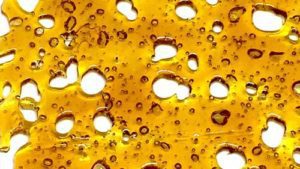As you know, smoking and digesting buds or flower marijuana has been around many, many years. In recent years, another option that has been gaining popularity is utilizing concentrates. Now there are various types concentrates on the market; shatter, wax, resin to name a few. The appeal of using concentrates is the fact that these products can be purer, have better flavor, a more immediate and consistent effect than edibles. The high is higher and the odor is not as strong as when smoking a joint. There is a belief that concentrates are cleaner than traditional cannabis because they’re free of plant matter. But concentrates can have issues too like possible concentrated impurities from the original plants, residual from the butane during the extraction process and because they are more potent, users can be surprised by a more rushing, cerebral high. Consider this, normal flower buds have between 15%-20% THC, in concentrates THC level is 80% or more!
To consume a concentrate, people will use a glass pipe called a “dab rig”. A dab rig is a specific type of bong that is used to smoke concentrates and oils. This is also known as dabbing. The concentrate is place on the hot surface (nail), you then inhale the vapor through the mouthpiece of the dab rig.
With dabbing it doesn’t take as long to feel the effects of the THC and you don’t use as much concentrate as you would buds.
Shatter
Shatter is translucent and looks like rock candy. It is produced like most other concentrates using butane but has the consistency of thin flat broken pieces of hard sugar candy. Shatter’s transparent quality is the result of the temperatures used during extraction. Although shatter looks like rock candy, it is generally considered to be the purest and cleanest type of extract.
Wax
Like shatter, wax is a BHO concentrate that has the consistency of coconut oil and looks like solid bee’s wax. Like shatter, wax starts off as the amber liquid that results from butane extraction.
So, what is the difference between shatter and wax?
The first difference is in the extraction process. Both shatter and wax are Butane Hash Oil concentrates with about the same THC potency. Basically, this method forces butane through cannabis plant material to extract the essential oils (made up of cannabinoids, terpenes, and flavonoids). These oils are known as Butane Hash Oil (BHO) and after the butane is evaporated, what remains is a highly-concentrated substance. The extraction process to produce wax uses less heat than when producing shatter. In wax, the molecules are less aligned and not as tight as when shatter is produced. Therefore, wax is more dense and muddy color than shatter. One of the many misconceptions about shatter is that the clearer it is, the more the amount of THC it contains. This is not true. Both shatter and wax are BHO concentrates that have roughly the same THC potency.
Due to its glassy texture, shatter can be more difficult to use but has a longer shelf life than that of wax. When smoked, shatter has less of a scent than wax but has the same effects. Both products are suitable for dabbing, and offer many of the same benefits, though it is more common to use wax for bowl topping. Bowl topping with wax allows for a person to increase the potency as well as the flavor of their normal flower. Shatter’s harder composition makes it preferable for dabbing and vaporizers, but you could also add a small amount on top of a bong for a more intense experience.
Which is better to use, shatter or wax?
It all comes down to preference. Both will give you the same results. If just starting out with concentrates, wax may be the easier of the two. Concentrates have been gaining popularity on the medical side for pain management because of the more powerful and longer lasting effect.

